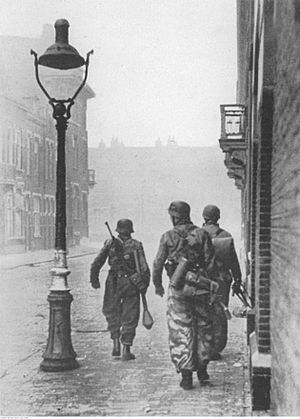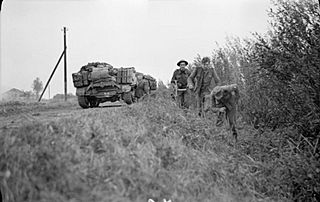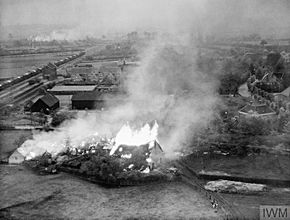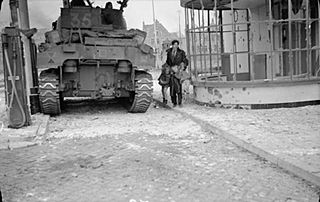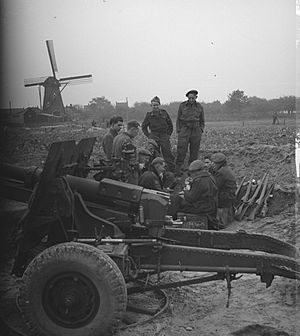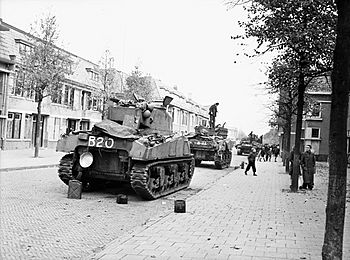Operation Pheasant facts for kids
Quick facts for kids Operation Pheasant |
|||||||
|---|---|---|---|---|---|---|---|
| Part of the Western Front of World War II | |||||||
|
|||||||
| Belligerents | |||||||
| Commanders and leaders | |||||||
| Units involved | |||||||
|
|
||||||
| Casualties and losses | |||||||
| Unknown | ~8,000 captured | ||||||
Operation Pheasant, also known as the Liberation of North Brabant, was a major military operation during World War II. It aimed to remove German troops from the province of North Brabant in the Netherlands. This important offensive took place on the Western Front between October 20 and November 4, 1944.
The operation was carried out by the Allied 21st Army Group. It happened after Operation Market Garden failed and as the Allies worked to capture the important port of Antwerp.
During Operation Pheasant, Allied forces successfully freed several cities. These included Tilburg, s-Hertogenbosch, Roosendaal, Bergen op Zoom, Willemstad, and Breda. The offensive broke through German defenses along canals and rivers, clearing most of the Brabant region.
Contents
Why Operation Pheasant Was Needed
In September 1944, the Allies launched Operation Market Garden. This was a big attack through the southern Netherlands towards the Rhine river. The goal was to cross the Rhine and bypass the Siegfried Line, a strong German defense line. This would open the way to Berlin.
Allied airborne troops managed to take some bridges. However, delays and strong German resistance led to a defeat at the Rhine bridge in Arnhem. The Allied advance stopped south of the Lower Rhine. This left a narrow strip of land, called a "salient," that was open to German attacks. German forces tried to attack this area, especially near Nijmegen, but were pushed back. The Allies called this vulnerable area "the island."
German forces also attacked from another area near the Meuse river. This threat was removed after a costly battle called Operation Aintree. However, this meant the area further west, towards Tilburg and s-Hertogenbosch, also became a threat. This area needed to be cleared to make the front line wider and safer.
By October 16, Field Marshal Bernard Montgomery, who led the 21st Army Group, changed the focus of the British 2nd Army. He wanted its full strength to help open the port of Antwerp. This port was vital for supplying the Allied forces. The army's right side would move along the Maas river. Its left side would pass about 10 kilometers (6 miles) south of Tilburg.
This put the XII Corps, led by Lieutenant-General Neil Ritchie, on the left side of the Eindhoven-Nijmegen corridor. They faced west. On the right side of the corps were the 53rd (Welsh) Infantry Division and 7th Armoured Division. They were supported by the 4th Armoured Brigade and 33rd Armoured Brigade. The left side had two Scottish divisions: the 51st Highland Division and 15th Scottish Division. They were supported by the 6th Guards Tank Brigade.
Allied Battle Plan
The Allies created a plan to free the central and western parts of North Brabant province. This involved a strong push west from 's-Hertogenbosch to Breda. To help the ongoing Battle of the Scheldt, the Allied 21st Army Group launched this attack.
The Canadian 1st Army would attack from Belgium in an operation called Suitcase. The British 2nd Army would attack from the Netherlands on the exposed western side of the Nijmegen corridor. The entire operation was code-named Pheasant and began on October 20.
On the first day, the 53rd Welsh and 7th Armoured divisions (in Operation Alan) aimed to clear 's-Hertogenbosch. This city, with 50,000 people, was like an old fortress. It had ramparts, a moat, and a citadel, all cut through by rivers and canals.
Operation Colin involved the 51st Highland Division. They would attack alongside the 15th Scottish Division on their left. Their goal was to capture Tilburg and push north. The 153 Brigade aimed for the town of Schijndel. The 152 Brigade would clear the wooded area east of the River Dommel. The 154 Brigade, riding in Kangaroos, would be ready to move quickly. They aimed to take Esch, Boxtel, and Vught, as well as towns south of 's-Hertogenbosch.
The I British Corps, led by Lieutenant-General John Crocker, would support Colin on the left. The Polish 1st Armoured Division aimed to capture Breda. The Canadian 4th Armoured Division would attack towards Bergen-Op-Zoom. On the Polish left, the British 49th Polar Bears Division planned to strike Willemstad. They also wanted to create a bridgehead over the River Mark. This river was the German 15th Army's only crossing point over the wide Hollands Diep estuary. The US 104th Timberwolf Division was assigned to help the British I Corps.
German Defenses
Facing these two Allied corps was the German 15th Army. This army was part of Heeresgruppe ‘B’ and was commanded by General Gustav-Adolf von Zangen. It included the LXXXIX Corps, LXVII Corps, and LXXXVIII Corps.
Operation Pheasant Begins
British XII Corps Attacks
The attack started on the night of October 22. The Royal Artillery of XII Corps fired on German positions in Nuland. The Corps advanced soon after, but bad weather stopped air support. Later, visibility improved, and RAF planes helped. Medium bombers, Hawker Typhoons, and Supermarine Spitfire fighter-bombers attacked bridges. They destroyed the 15th Army's headquarters at Dordrecht, killing two generals and seventy staff officers.
The 53rd Welsh Division, with its 71st and 160th Brigades, attacked Nuland with the 7th Armoured Division. The 71st Brigade pushed from the Vinkel-Papendijk line in the south. The 160th Brigade attacked from the Loonschestraat line. Nuland was cleared by 7:45 AM, and two German battalions fled. A German counterattack later that day was stopped by machine gun fire.
Operation Colin
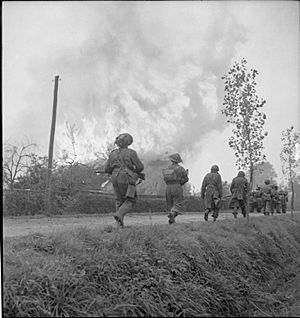
The 51st Highland Division attacked from Eerde, near Veghel, about eleven miles from ‘s-Hertogenbosch. They faced the experienced 59th Wehrmacht infantry division. This German division held the 'Eerde Line' between Boxtel and Veghel.
The attack began at dawn on October 23. The Highlanders took Schijndel easily and then pushed on despite growing resistance. The 152nd Brigade attacked the woods east of the River Dommel. They also fought near Boxtel and the Schijndel dyke. The Scots fought against tough German paratroopers and took their objectives, though with some losses. They eventually reached Vught and freed the Herzogenbusch concentration camp. This was a concentration camp built on Dutch soil.
Fighting in Vught was confusing. The 7th Black Watch faced heavy shelling from Fort Isabella. But by 3:00 PM, this resistance was overcome. Meanwhile, the 7th Armoured Brigade was stopped by German guns at Loon op Zand. The 153rd Brigade was sent to help. Together, they took the town and then moved north, reaching Sprang by October 30. The 154th Brigade then moved northwest towards Raamsdonk, which they reached by the end of the day.
Desperate Germans tried to keep their escape route open. But the British crossed the Donge river after finding an intact bridge. They then took Geertruidenberg without resistance. A small German counterattack failed to stop the British. They found the bridge over the River Maas blown up.
After taking Schijndel, the Scots moved into Boxtel. They found it abandoned by the Germans. During the celebrations, the 2nd Seaforth rescued 100 escaped soldiers and airmen from the 1st Airborne Division. These men had escaped from Arnhem. However, the bridge at Hal was blown up and strongly held by the Germans. Operation Colin was now over, and the division rested for a few days. Further south, the 15th Scottish Division moved towards Tilburg.
After this successful phase, two German areas remained south of the Meuse river. The largest was around 's-Hertogenbosch.
Operation Alan – The Battle for 's-Hertogenbosch
In the early hours of October 24, the 1/5th Battalion, Welch Regiment and the 1st Battalion, East Lancashire Regiment began a night march. They used artificial moonlight along the railway. In 's-Hertogenbosch, the 53rd Division faced the experienced 712th Wehrmacht Infantry Division.
The Inniskilling Dragoons of the 7th Armoured Division met strong resistance, especially at Middelrode. But after hard fighting, the 53rd Division gained a foothold in 's-Hertogenbosch in the early hours. By 4:30 AM, leading troops reached the city's northeastern edge. They moved quickly against Germans near the small canals. They bridged the waterways that cut through the old citadel. Troops moved in with Churchill tanks. Crocodile flame throwers from the 79th Armoured Division also supported them.
The 1/5th Welch tried to clear the northern city and capture the River Dieze bridge. This plan went wrong. A leading platoon got lost. The bridge was found intact but was later blown up, trapping the men. German self-propelled guns then moved in, and a fierce battle lasted twelve hours. One German gun was destroyed by a PIAT. But with ammunition running out, the trapped platoon of about fifty men had to surrender. Some tried to swim back across the river.
As the rest of the brigade moved in, the 1st Battalion East Lancs cleared the south of the river. They ambushed a German column withdrawing into the city from the east. Tanks and armoured carriers of the Inniskilling Dragoons rode on the railway line. This was a bumpy and exposed ride, but they soon joined the infantry. Supported by these tanks, the East Lancs tried to capture two bridges over the River Aa and Zuid Willems Vaart Canal. The River Aa bridge was taken intact, but the Zuid Willems Vaart Canal bridge was blown. The battalion then took positions between the two canals and moved into the town. They pushed through the eastern side of the city. Their leading platoons neared the railway bridge over the River Dommel. After fierce fighting, they reached the bridge, only to find it blown. By nightfall, however, a nearby lock over the canal near the Railway Station was found intact.
The next day, the 7th Royal Welch crossed the lock. They used smoke, mortar fire, tanks, and Crocodile flame throwers for cover. Their attack surprised the Germans, and they captured 25 prisoners. The rest of the battalion crossed, securing a strong bridgehead on the Dommel's western bank. Further along, Royal Engineers built a Bailey bridge. After it was completed, the northern area was cleared. The 6th Battalion tried to cross the canal by boat, but after one was sunk, they pulled back. The Germans had reinforced the area overnight. The East Lancs from the south continued north along the Dommel's bank. The Royal Welch cleared the city to their west. The East Lancs linked up with the Welch around 10:00 PM, securing all bridgeheads over the Dommel.
On October 26, the British moved north towards the Railway Station, which was burning fiercely. The advance continued into the night. The German soldiers fought fiercely in house-to-house combat. But the British gradually wore them down, securing key buildings and taking prisoners. The German commander, Major Riehl, was later captured.
By the evening of October 27, German resistance mostly stopped, and the city was freed. The 160th Infantry Brigade replaced the 158th Brigade (except for the 7th Royal Welch) in the west of the Dommel. The 158th Brigade moved to reserve east of the city. The battle was hard-won. 145 British soldiers and 253 Dutch civilians died, along with many Germans.
Tilburg is Liberated
Further south, a column from the 15th Division and 6th Guards Tank Brigade captured Oisterwijk on October 26. The main part of the 15th Division then joined attacks on Tilburg, a large industrial city. The Scots were helped by the Royal Netherlands Motorized Infantry Brigade, who attacked from the south. The Dutch could not reach Tilburg and were stuck at Broekhoven, where fighting took place. Four Dutch soldiers were killed, but their efforts distracted the Germans.
As a result, the 44th Lowland Infantry Brigade entered Tilburg with little resistance. They freed the town on October 27 after the Germans pulled back. There were huge celebrations, as the liberation surprised both the Dutch and the Germans. The 15th Scots were then stopped from advancing further. The Scots Greys advanced towards Goirle to meet parts of the Polish 1st Armoured Division.
The 15th Division and 6th Guards Tank Brigade were ordered to quickly rejoin VIII Corps. This was on the eastern flank, where a German counterattack had started in the Peel marshes.
I British Corps Advances
The I British Corps began its attack on October 23. They aimed to push from the South Beveland area towards the important Hollands Diep waterway. This would squeeze the Germans into a smaller space. The Corps included the 4th Canadian Division, 2nd Canadian Armoured Brigade, 1st Polish Armoured Division, the new US 104th Timberwolves infantry division, and the British 49th Polar Bears Division. They were supported by the 34th Armoured Brigade.
Operation Suitcase started at the same time as Pheasant. The Belgian town of Esschen was taken two days later by the Algonquin Regiment. Mines and roadblocks slowed the advance, but there was little actual combat at first. This changed after crossing into the Netherlands. Wouwse Plantage was taken after some casualties.
On October 26, Field Marshal von Rundstedt ordered the German 15th Army to pull back. He wanted them to avoid a breakthrough and save their strength. The new line was Bergen op Zoom/Roosendaal/Breda/Dongen/west of 's-Hertogenbosch.
Bergen-op-Zoom is Freed
On October 27, the Canadian 4th Armoured Division reached the edge of Bergen-op-Zoom. Two infantry companies from the Lincoln and Welland Regiment had moved ahead on tanks. The Canadian advance forced Von Rundstedt to move the elite 6th Parachute Regiment. This unit had been blocking the 2nd Canadian Division on the Beveland isthmus. Now, it had to defend Bergen op Zoom. The Algonquin Regiment tried to surround German positions at Steenbergen. The Governor General's Foot Guards headed towards Steenbergen.
After some confusion about who was defending the city (mostly the 711th Infantry Division), the South Alberta Regiment and the Lincoln and Welland Regiment entered the city the next day. They liberated most of it. They reported that the people of Bergen op Zoom were "as enthusiastic and wild as any yet seen." However, the Germans still held the north of the city. The elite German 6th Parachute Regiment fought hard. They used panzerfausts and self-propelled guns to destroy Canadian tanks. But they pulled back into Steenbergen when the Foot Guards threatened to cut off their escape.
The Germans completely abandoned Bergen op Zoom on October 30. The next day, the Algonquin Regiment and the Grenadier Guards attacked Welberg, a village near Steenbergen. The 6th Parachute Regiment defended the village strongly. Most of the Canadian 4th Armoured Division had to fight for three days to take Welberg.
Several days passed before the entire I British Corps could cross north. This was along the line connecting Breda and Bergen-op-Zoom via Roosendaal. After taking Breda, the Polish 1st Armoured Division and the Canadian 2nd Canadian Armoured Brigade drove towards Moerdijk. Moerdijk had important bridges across the Hollands Diep. They soon reached the Mark river and its canal. Hard fighting followed, but they could not establish a bridgehead across the canal before the end of October.
With the Canadian Army already in Esschen and Bergen op Zoom, the German LXVII Corps near Korteven was in danger of being surrounded. Otto Sponheimer's LXVII corps was already allowed to start a general withdrawal. The Canadians took Korteven and the area between it and the sea. This meant they could focus on the Scheldt battle, where they carried out Operation Vitality.
Breda and Mark Canal Bridgehead
The I British Corps continued fighting its way north in the coastal area. By the end of October 27, Stanisław Maczek’s Polish 1st Armoured Division attacked the city of Breda. They did this after cutting the road from Tilburg.
The Division split into two groups to free Breda. A southern group advanced from Gilze through Bavel to Breda's southern edge. The northern group attacked through Molenschot and Dorst. They then surrounded the northern edge of the town.
In the early hours of October 29, both groups attacked Breda. Gilze was soon taken by the Poles, followed by Molenschot and Dorst. German artillery and a counter-attack near Dorst slowed the advance on Breda. But the counter-attack was pushed back. The Germans retreated north, and the next day, the entire town was freed. Wild celebrations took place as the Poles were welcomed. 42 Polish soldiers and two Canadians were killed, and twice that number were wounded. But civilian casualties and damage to the city were light.
To capture the bridges of the River Meuse, the Mark Canal had to be crossed. This would widen the Allied line. On October 31, the Poles captured Moerdijk. They were supported by the Royal Artillery about 4 kilometers (2.5 miles) away near Zevenbergen. The artillery noted the rapid advance of the Poles. The Poles managed to cross the canal. However, as reinforcements arrived, the Poles faced heavy German counterattacks. The Poles fought off the attack. But the next day, the Germans attacked with more strength. Throughout the day and into the evening, the Poles desperately held onto the bridgehead. Only when artillery was fired on their own position did the German attack stop.
US Drive to Mark River
The American 104th Timberwolves infantry division traveled from France to help the 21st Army Group. They were positioned on the left side of the British 49th Infantry Division and the Polish 1st Armoured Division. They joined the offensive on October 20.
By October 30, after five days of fighting, the division had pushed about fifteen miles. They were within sight of the Mark River. They liberated Zundert after a hard fight. Soon after, they controlled the Breda-Roosendaal Road and overran the Vaart Canal defenses. Achtmaal, Leur, and Etten fell as the division advanced to the Mark River, arriving by October 31. A coordinated attack over the Mark River at Standdaarbuiten on November 2 created a bridgehead. The rest of the division crossed the river. For the next two days, the Timberwolves chased German remnants north to the Hollands Diep. Zevenbergen was captured, and the Hollands Diep was reached on November 5.
Operation Rebound – Roosendaal to Willemstad
The British 49th Polar Bear Division and the 4th Canadian Armoured Division moved towards Breda. The Polar Bears were to attack towards Loenhout. Then, they would use Clarkeforce to push through and move up the main road to Wuustwezel in Operation Rebound. On October 20, Rebound began with an artillery barrage. Clarkeforce launched at 4:00 PM, bypassing some strongpoints for supporting troops to clear. They reached an area called 'Stone Bridge'. The fight for this point took most of the afternoon. But the bridge was captured before it could be completely destroyed. Clarkeforce pushed across it and into Wuustwezel from the rear, taking about 500 prisoners that day. The tanks then pushed on in the dark until German roadblocks stopped them.
The division then advanced towards Nieuwmoer. The leading part of Clarkeforce was stopped by German-held woods. After artillery pounded the woods, the advance continued. On October 22, Esschen was reached and taken after clearing scattered German groups. The 56th Infantry Brigade prepared the way by advancing from Esschen to Nispen on the night of October 25/26. Clarkeforce pushed towards Brembosch the next morning against strong German rearguards. They faced many obstacles and German resistance. They had to cross a huge anti-tank ditch, which they managed. Soon, the 49th Division would face a German counterattack.
The loss of Esschen and its vital crossroads angered the Oberkommando der Wehrmacht (German High Command). They realized this was their weakest point. Withdrawal was refused, and the commander of LXVII Corps, Otto Sponheimer, launched a large counterattack. The 49th Division faced the full force of the 245th Infantry Division's counterattack. This division was ordered to retake Wuestwezel with artillery support. The counterattack hit the Leicestershire Regiment hard. Two platoons of its A Company were overrun, and six German tanks broke through. Nevertheless, the rest of the Leicesters fought back. With Churchill tanks, four German tanks were destroyed. The Germans continued the attack until evening, then withdrew. They had suffered heavy losses in men and had thirteen tanks and self-propelled guns destroyed.
By October 31, Clarkeforce had moved through Wouw and reached Roosendaal. An artillery and armor-supported attack on the city was ordered, as heavy resistance was expected. However, a patrol discovered in the mist that the Germans had pulled out. This saved the city and its people from further destruction. The 49th Division's final goal was Willemstad on the Hollands Diep. This was 10 kilometers (6 miles) away across land not suitable for tanks. So, Clarkeforce was disbanded, and the division advanced as regular infantry. Willemstad was freed with almost no resistance on November 6, after the German troops withdrew across the Hollands Diep.
German Retreat and Final Battles
Von Rundstedt understood the danger of this Allied attack. He tried to draw away British forces. On October 26, two German mechanized divisions attacked Dempsey's thinly held positions in the Peel marshes, further south. The US 7th Armoured Division took the brunt of this attack and was in danger of being cut off near Meijel. However, Dempsey reacted quickly. He moved the 15th Scottish and 6th Guards Tank Brigade from Tilburg. Within a day, they were concentrated behind the Americans. From October 29 to November 7, in tough fighting often in mud and rain, this force pushed the Germans back to their original positions. This threat was removed.
With the complete failure of the counterattack, von Rundstedt allowed the 15th Army to pull back. He wanted to prevent its destruction. The new line was the Mark river and the Mark Canal. The German front between Bergen-op-Zoom and ‘s-Hertogenbosch via Breda had already been broken. The area south of the Maas river was also lost.
Von Rundstedt told Hitler that the 15th Army had to retreat across the Waal river. But Hitler ordered them to hold their ground south of the Maas. As the 15th Army's situation worsened, von Rundstedt asked for new orders. Hitler's response simply repeated his demand and said that major reinforcements were ordered for the 15th Army. More importantly, Generaloberst Kurt Student, who led the 1st Parachute Army, was ordered to take command of all German forces in the northwestern Netherlands. This new group, called Army Group Student, officially began on November 11. It was later renamed Army Group H.
End of the Offensive
On November 4, the 51st Highland Division attacked across the Afwaterings Canal. This was a small German area just west of 's-Hertogenbosch. This operation, called Operation Guy Fawkes, was helped by the 7th Armoured Division on its left. Against scattered resistance, they cleared a 24-square-mile area and eliminated the German position within a few days. By November 5, the constant pressure from I Corps, greatly helped by RAF fighter bombers, had broken the German line at the Mark river. Over the next three days, the corps moved up to the Maas river. However, they were not fast enough to stop the Germans from destroying the Moerdijk bridges. This brought the offensive to an end.
What Happened Next
After Operation Pheasant ended, Canadian troops took over responsibility for the Maas river line. They also took over the Nijmegen area from the XXX Corps.
The German retreat did not turn into a complete collapse. They used delaying tactics and fought hard against the Allies. The Allies could not deliver a final knockout blow. However, they achieved their main goal: clearing German forces from the region between Antwerp and the Maas. This secured Allied supply lines. The offensive also completely cut off the Germans who were still holding positions at the mouth of the Scheldt River. As a result, by November, with Walcheren fully secured, over 40,000 Germans surrendered. With the Scheldt river clear of obstacles and German guns, Antwerp became the most important port for the Allies in the coming months.
The Germans suffered heavy losses. The 15th Army lost 8,000 prisoners and many more killed or wounded. The 712th Division, which lost nearly 1,700 prisoners and many killed or wounded, was rebuilt and sent to the Eastern Front. The 59th Infantry Division was moved to "the island" to defend it. For the Dutch, the liberation was a great relief. Brabant was now almost completely free. The liberated towns and cities suffered only minor damage, except for 's-Hertogenbosch. Tilburg, Willemstad, Breda, Roosendaal, and Bergen op Zoom were all captured mostly unharmed. Civilian casualties were light because major fighting was avoided as the Germans withdrew from those places.
After the success of Pheasant and the defeat of the German counter-attack at Meijel, two German areas remained south of the lower Maas river. One was a small bridgehead west of ‘s-Hertogenbosch, facing XII Corps. The other was along the Mark river, facing British I Corps.
In November and December, North-West Limburg was freed by the British 2nd Army. By this time, most of the southern Netherlands, south of the Rhine, was free from German occupation. Eastern North Brabant was freed after the Battle of the Bulge. The final step in freeing the Netherlands south of the Rhine was British and Canadian operations. These included Operation Blackcock in January 1945, and then finally moving into the German Rhineland with Operation Anger in April.
Remembering the Operation
-
Commonwealth War Graves Commission's Canadian cemetery in Bergen Op Zoom
In 's-Hertogenbosch, there is a memorial for the soldiers of the 53rd Welsh Division who died. The square behind it is called the 53rd Welsh Division Square. An annual ceremony takes place on October 27. There are also memorials or monuments in Tilburg, Breda, and Roosendaal for the divisions that freed those cities.
- Media
An episode of Who Do You Think You Are? from 2009 featured British comedian Rory Bremner. His father, Major Donald Bremner, was involved in the fighting in 's-Hertogenbosch.


